Harvest in the garden largely depends on the condition of shrubs and trees in the spring, at the exit from wintering. Not only frost, cold wind, snow pressure on the crowns, bright winter sun, changing thaws and frosts can cause local damage or death of the whole plant. Resistance to weather factors depends on the immunity of the tree or bush, the maturity of young shoots, the concentration of sugars and proteins in the cell sap - these indicators can be changed for the better by performing several care measures.
Content
Work plan
Preparing a garden for winter for beginners can be a daunting task due to a lack of understanding of the timing and sequence of procedures. Timing depends on the dynamics of cooling and weather in the fall, which can vary significantly in different seasons, even in one region. But the sequence of work can be clearly defined:
- At the end of the harvest, trees and shrubs should be fed, since their roots after fruiting actively grow, absorbing nutrition from the soil.
- Pruning of branches should be carried out when the trees go into a state of rest, as indicated by crumbling foliage. At this point, the plant will undergo a traumatic procedure easier than in the period before the juice stops.
- After pruning, it is necessary to carry out sanitary procedures in the garden - harvesting leaves, removing weeds, clearing the trunks from the old bark.
- Having finished with the cleaning, you should dig the soil in the near-stem circle, whitewash the trunks and perform treatment from diseases and pests.
- When the air temperature reaches a level slightly above zero, you need to conduct pre-winter watering and mulch the trunk circle, warming the roots.
- Only after completing these procedures can one establish shelter for young trees and trunks.
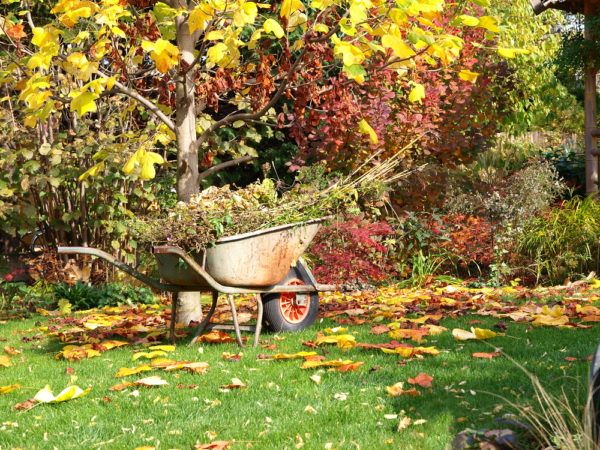
Cleaning
Cleaning the garden is an obligatory step in preparing trees and shrubs for the coming winter. Some gardeners postpone pruning in the spring, as well as treatment for diseases, if it is purely preventive, depending on the weather and the region, winter watering or shelter may not be required, but cleaning is necessary in any case. Fallen foliage often becomes a refuge for the winter for fungi and larvae of pests, so collecting and burning litter is the simplest but most effective disease prevention. Together with the leaves, all weeds should be removed and burned.
False leaves can be used for mulching or put in a compost pile. But if the trees or shrubs suffered from any kind of fungal or viral disease, even in a mild form, the leaves fallen from them definitely need to be burned, otherwise the infection will spread next year. Broken branches that remained after trimming, especially those affected by scab or powdery mildew, also need to be collected and burned.
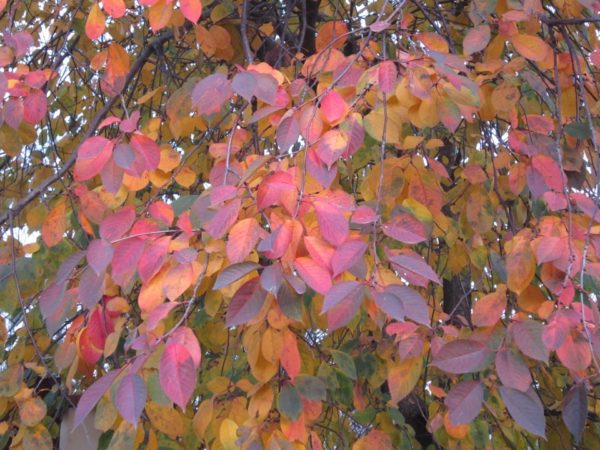 You may be interested in:
You may be interested in:Pruning
Autumn pruning branches can pursue several goals:
- disease prevention - it is necessary to remove shoots infected or potentially vulnerable to pathogenic microflora and harmful insects;
- thinning of the crown - an excess of branches deprives the fruit of the volume of sunlight necessary for ripening and provokes the development of fungi;
- rejuvenation - involves the removal of old branches, the fertility of which falls, or shortening of shoots, which stimulates the appearance of young shoots.
To perform the procedure, a well-sharpened knife or secateurs will be required - a dull blade will not allow you to make an even cut. For old branches use a hacksaw. The exposed living tissue of a shrub or tree can become an entrance for fungi and viruses, in order to avoid which it is necessary to process the slices with a garden var or 0.5% solution of copper sulfate.
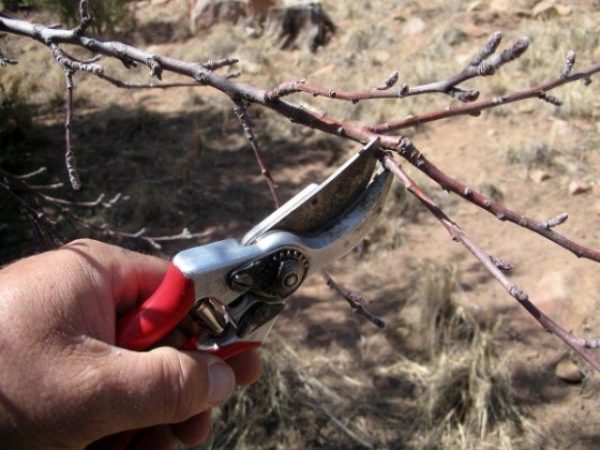
Garden var can be prepared from the following components:
- 400 g of resin (pine or spruce);
- 400 ml of turpentine;
- 100 g of fat;
- 100 g of beeswax.
Sections can also be painted over with oil paint or, as a temporary measure, covered with clay.
First of all, you need to cut branches damaged by a disease or insects, as well as dry and broken ones. After this, if necessary, perform anti-aging pruning or proceed to thinning the crown. When removing unnecessary branches, priority is given to weak, underdeveloped, having visible deviations in growth. In addition, the bush must be freed from all branches growing in the direction of the center of the crown.
Features pruning fruit trees
The removal of branches during the preparation of young trees for winter in the orchard is limited to minimal sanitary pruning - the loss of a large part of the crown provokes thickening and delayed formation of flowering buds, since the plant spends all its efforts to restore the cut growth. As a result, the tree gives a lower yield than without pruning.
On the contrary, pruning has a beneficial effect on the productivity of adult and old trees, especially if there is a decrease in the growth rate of shoots. In this case, shortening of all branches will be a good stimulation of growth processes. Cutting old branches entirely allows removal of no more than 1/3 of the total volume of the crown. The number of branches to be cut at a time should be minimized; therefore, pruning of trees should be done annually. When removing a branch, it is recommended to leave a small stump to prevent freezing of living wood, but in the spring it will be necessary to remove it.
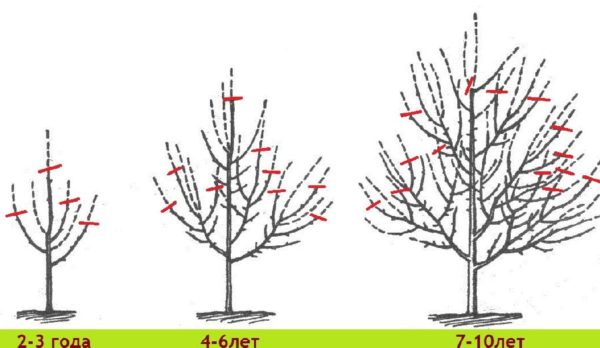
The specifics of pruning berry bushes
Shrubs are more demanding for anti-aging pruning. After the plant reaches a certain age, every year it is necessary to remove all old branches, leaving 10 to 15 shoots on the bush, with the majority of them sprouting at the peak of fertility.
The principles of pruning shrubs differ in different crops:
| Bush | Which branches to delete | Which branches to leave |
| Black currant | All branches are older than 5 years. | At least 5 annual shoots, two-year-old - from 3 to 6 pieces. A branch older than 4 years should be no more than 2-3 pieces, the remaining shoots on the bush - at the age of 3 years. |
| Red currants | Shoots over 8 years old. | Most of the bush should be made up of branches aged 3 to 6 years. It is necessary to leave 5 shoots at the age of 1-2 years and a couple at the age of 6-7 years. |
| White currant | ||
| Gooseberry | ||
| Raspberry | All the shoots bearing fruit last season. | 6-8 young shoots should be left, shortening the length of each of them by 10-12%. |
| Blackberry | It is necessary to leave 12-15 annual shoots. | |
| Grape | All but a few annual vines. Also, several shoots need to be cut to the level of "knots" with branches of 2-3 buds - substitution shoots will grow on them next year. | Leave required 4-5 annual vines. |
Top dressing
In the autumn period, garden plants need nutrition to ripen the shoots of the current year. Young growth, not having time to lignify before the onset of frost, can freeze, which will weaken the immune system and reduce productivity in future seasons. This excludes nitrogen from the autumn top dressing, which provokes the growth of shoots. Important elements in this period are phosphorus, which stimulates the lignification of green tissues, and potassium, which, in addition, increases frost resistance and plant immunity.
Organic top dressing
To feed organic matter in the autumn, you can use:
- cow dung;
- chicken droppings;
- compost;
- wood ash.
Manure is the best fertilizer for poor, depleted soils. Wood ash is a source of potassium, has the properties of a fungicide, and is optimally suitable for acidic soils, as it can be used for liming. Fertilizers such as cow dung and chicken droppings should not be fresh. Litter should be used dry, manure should be baked out for at least 4 months, but it is worth giving preference to older raw materials - 2-3 years. Compost must be maintained before application for at least a year.
Fertilizing in the near-tree circle of trees can be done during digging, planting into the soil to a depth of 15 cm.
| Fertilizer | Consumption per 1 m2 of the trunk circle |
|
Cow manure |
6-8 kg |
|
Compost |
2-3 kg |
|
Bird droppings |
500 g |
|
Wood ash |
150 g |
Another option for organic top dressing is sowing in the near-stem circles of garden shrubs and trees of siderata plants. It should be produced in September, you need to cut the stems after they reach a height of 20 cm. After that, dig the soil without removing the cut greens. You can also close up siderates into the ground with a plane cutter. The best options for green manure for the garden are oats, rape, rye.
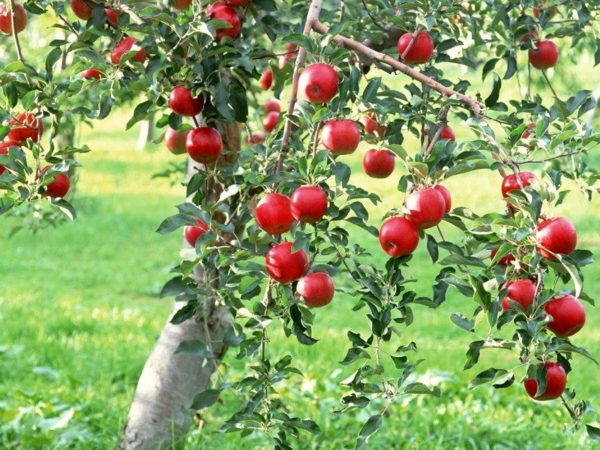
Mineral fertilizers
Mineral fertilizers can be applied in the form of a solution for irrigation or fall asleep in a hole prepared near the roots of the plant. For bushes, dig holes about 10 cm in depth, for trees - 15 cm. After pouring the desired amount of substance, fill it with water and bury a hole.
Fertilizer rates for adult plants:
| Plant | Superphosphate (g per 1m2) | Potassium sulfate (g per 1m2) |
| Apple tree pear | 40-60 | 20 |
| Cherry plum | 50 | 40 |
| Currant | 20 | 20 |
| Gooseberry | 40-60 | 20-25 |
| Raspberry | 40 | 20 |
Winter watering
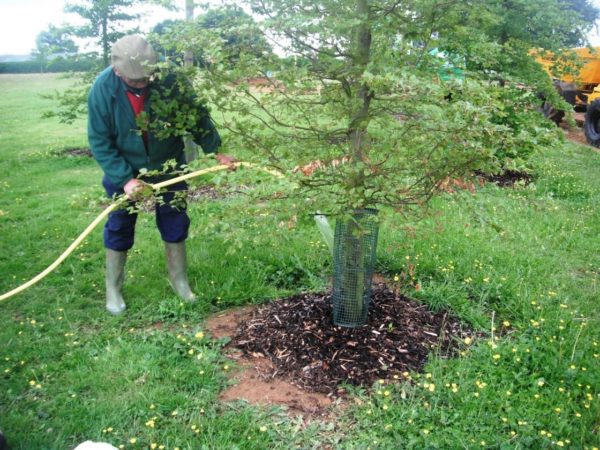
A plant will not be able to acquire good winter resistance unless it receives sufficient moisture in the autumn. In the rainy season, additional irrigation is not required, but during dry autumn, fruit trees and shrubs need water recharge irrigation.
The procedure must be carried out when it gets colder up to + 2 ... + 3 ° C. Water for irrigation should be warmer by about 5 ° C than air temperature. It is necessary to wet the soil to a depth of a meter, for this you should pour on average 10 buckets of water per 1 m2. For young bushes or trees not exceeding 1 m in height, 5 buckets for each will suffice.
Water should be introduced in several runs - pour no more than 10-15 liters per 1m2 every hour. After watering, it is useful to lay out a near-stem circle with a layer of mulch (peat, compost, humus, spruce branches) to keep moisture near the roots.
Pest protection
On the eve of winter, the prevention of diseases and pests in the garden should be carried out. During this period, there is no longer a risk of the accumulation of poisons in the fruits after processing, so you can use strong tools such as Bordeaux liquid, copper and iron sulfate. All substances well resist fungi, in addition, iron sulfate is effective in combating lichens, mosses and a number of pests, and Bordeaux liquid in a concentration of 3% acts against mold. From scab, coccomycosis and powdery mildew, processing with a urea solution is effective.
| the culture | vitriol (g per 1 liter) | copper sulfate (g per 1 liter) | carbamide (g per 1 liter) |
| Apple tree, pear, quince, chokeberry | 50 | 10 | 50-70 |
| Cherry, plum, apricot peach | 30 | 5-7 | 3-4 |
| Currants, raspberries, gooseberries | 25 |
Both the aerial part of the plant and the soil in the near-stem circle should be sprayed with therapeutic solutions. The soil must first be dug up, turning the strata at a depth of 10-15 cm - it is at this level that many pest larvae winter, having hit the soil surface, some of them will freeze. Between the rows, the soil needs to be dug to a depth of 15-20 cm. The larvae found during digging must be selected from the soil to prevent them from digging deeper.
Many species of pests hide under the bark of trees, there is an active reproduction of bacteria. To disinfect, the remaining bark should be brushed off with a metal brush or a garden scraper, and if necessary, moss and lichen should be removed from the trunks. Cleaning should be done carefully - only that part of the wood that has already died out and is peeling off the trunk should be removed. Damage to live wood that conducts juices injures the plant. For young trees, such treatment is not required. Both the aboveground part of the plant and the soil in the near-stem circle should be sprayed with medicinal solutions. The soil must first be dug up, turning the strata at a depth of 10-15 cm - it is at this level that many pest larvae winter, having hit the soil surface, some of them will freeze. Between the rows, the soil needs to be dug to a depth of 15-20 cm. The larvae found during digging must be selected from the soil to prevent them from digging deeper.Tattered bark must be burned to prevent the spread of disease. It is worth laying a film or tarpaulin in the trunk circle before starting the procedure so that the larvae of pests or bacteria do not get into the ground.
Trunks cleared of bark, as well as skeletal branches of shrubs, are advised lime. This procedure will protect plants from harmful microflora. To enhance protection against fungi, whitewash can be added to whitewash, as well as glue - for better adhesion of the mixture to the surface of the trunk. The dosage of the components for such a solution:
- 6 kg of lime;
- 1 kg of copper sulfate;
- 200 g of wood glue;
- 30 liters of water.
It is allowed to add 3 kg of clay to this mixture.
In hungry winter time, rodents can attack the garden, eating sections of the bark, which contributes to freezing of wood. As a rule, it is enough to protect the lower 0.5-1 m of the trunk so that the animals do not reach it. You can find special plastic nets on sale, the advantage of which is breathability - this ensures that the barrel does not block when the temperature rises. Tree trunks can be tied with strips of ruberoid, bamboo rugs, a construction bandage, kraft paper, spruce branches, nylon stockings, but if there are strong thaws in winter, this protection can be harmful, and in the spring it should be removed as soon as the snow begins to melt.
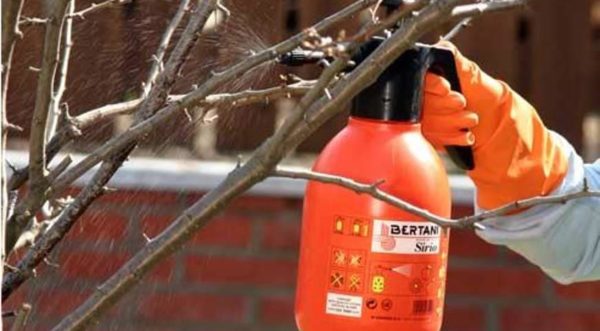
Weather protection
When preparing fruit trees and shrubs for winter, it is important to know that frost poses the greatest danger to the roots. The consequences of shoot damage, depending on the severity, can be completely eliminated in two or three seasons, resuscitating a plant with a frozen root system is a difficult and often impossible task. Therefore, the trunk circle should already be covered by a thick layer (5-7 cm) of compost or peat already to the first frosts. On acidic soils, peat should be replaced with sawdust or crushed bark. In the regions at the Moscow region level, this procedure should be carried out in late October, or in extreme cases, in early November.
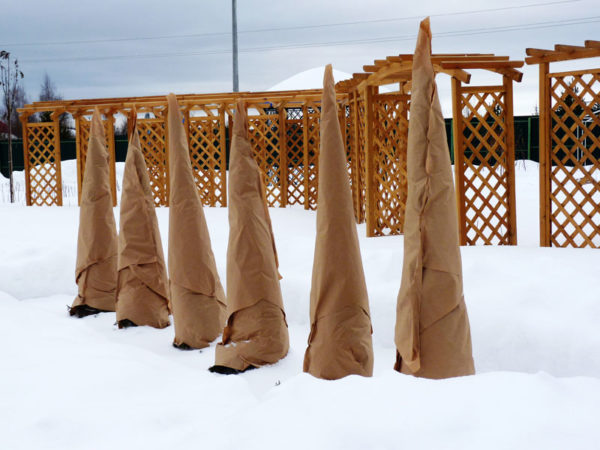 You may be interested in:
You may be interested in:Tree trunks are covered in order to protect from wind, moisture penetration into cracks of the bark, which, when frozen, can damage the tree and sunburn. It is especially important to cover those trees in which the living layer of the bark has been damaged.
Young trees and bushes are most vulnerable to weather, especially wintering in the open ground for the first or second year. Lacking reliable protection in the form of bark, shoots of young plants are sensitive to the draining action of wind and sun and quickly grow during warming. If, after the thaw, the temperature drops to negative values, the overgrown greens will be damaged by frost, the branches will begin to rot.
Shelter should be erected at a temperature not lower than -5 ° C. The branches of seedlings must first be tied to provide them with resistance to gusts of wind or the severity of snow. The vine should be bent to the ground.
As a shelter use:
- film;
- agrofibre;
- fir branches;
- shields.
The choice of material depends on the weather characteristic of the region. The film provides insulation from moisture, but is a weak barrier to frost, like agrofibre. Wooden boards, plywood sheets or slate protect the plant from wind gusts and snow pressure, optimal if you want to prepare the garden for harsh winter. Spruce branches provide air access, delay the layer of snow, which gives additional insulation, and scare away rodents.
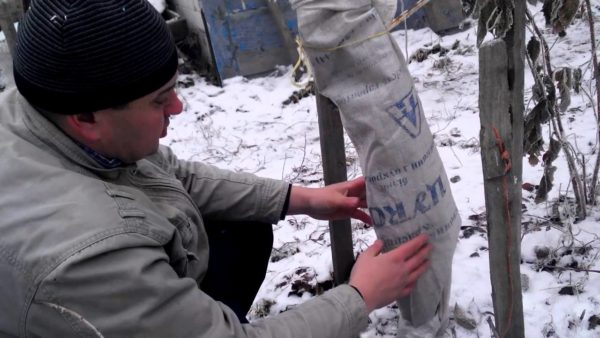
A novice gardener should pay attention to the fact that most of the procedures should be carried out after leaf fall, but before zero temperatures are established. If the cooling is rapid, most of the events will have to be put in a couple of days. Therefore, inventory and chemicals should be prepared in advance.

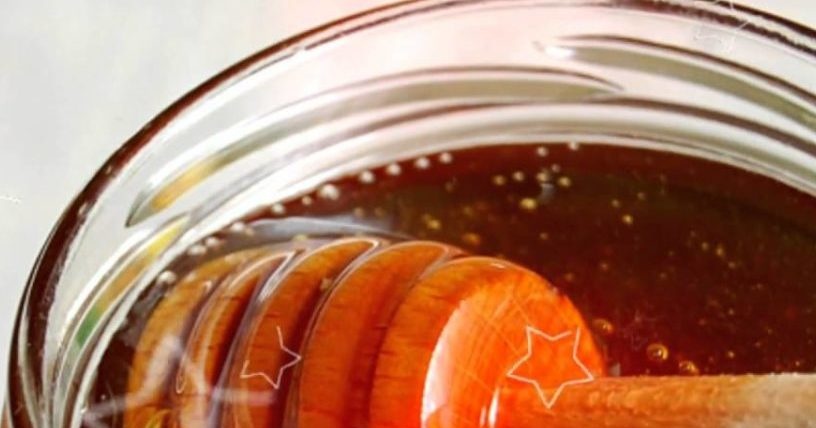
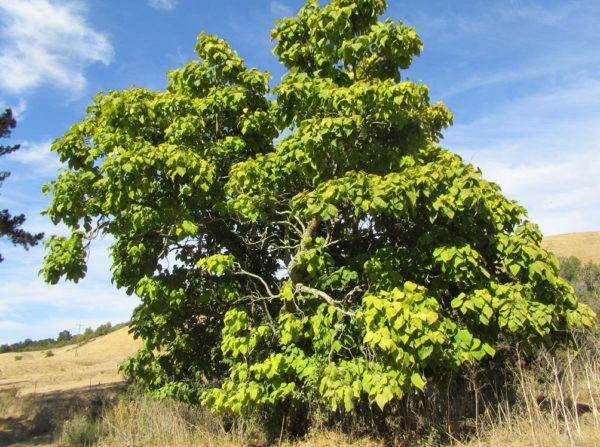
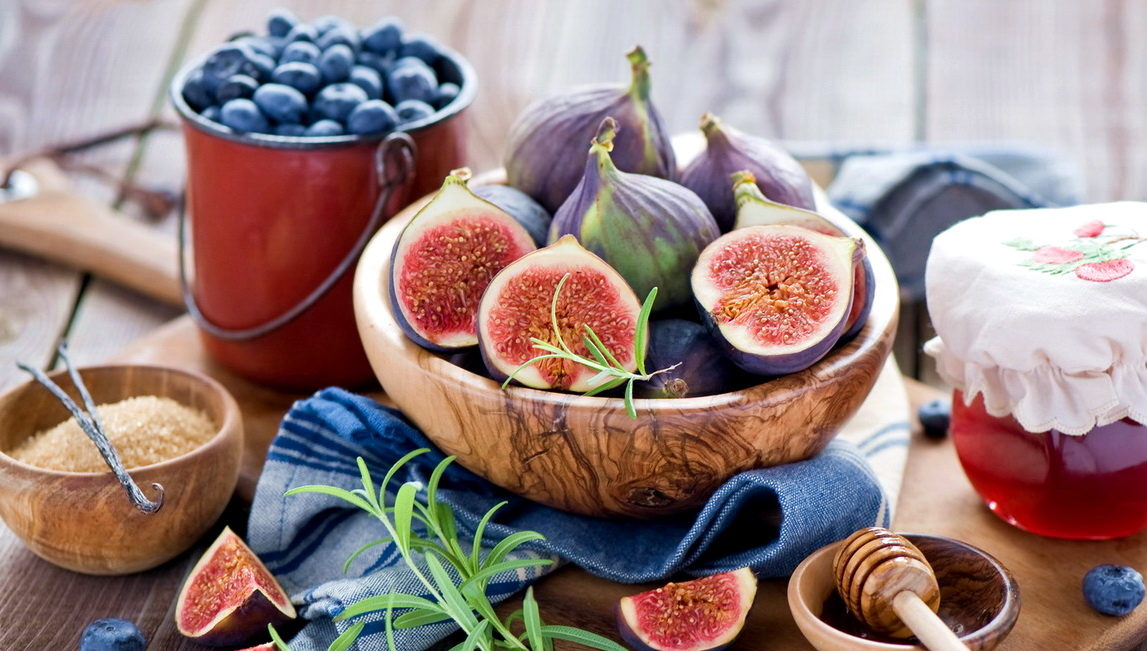
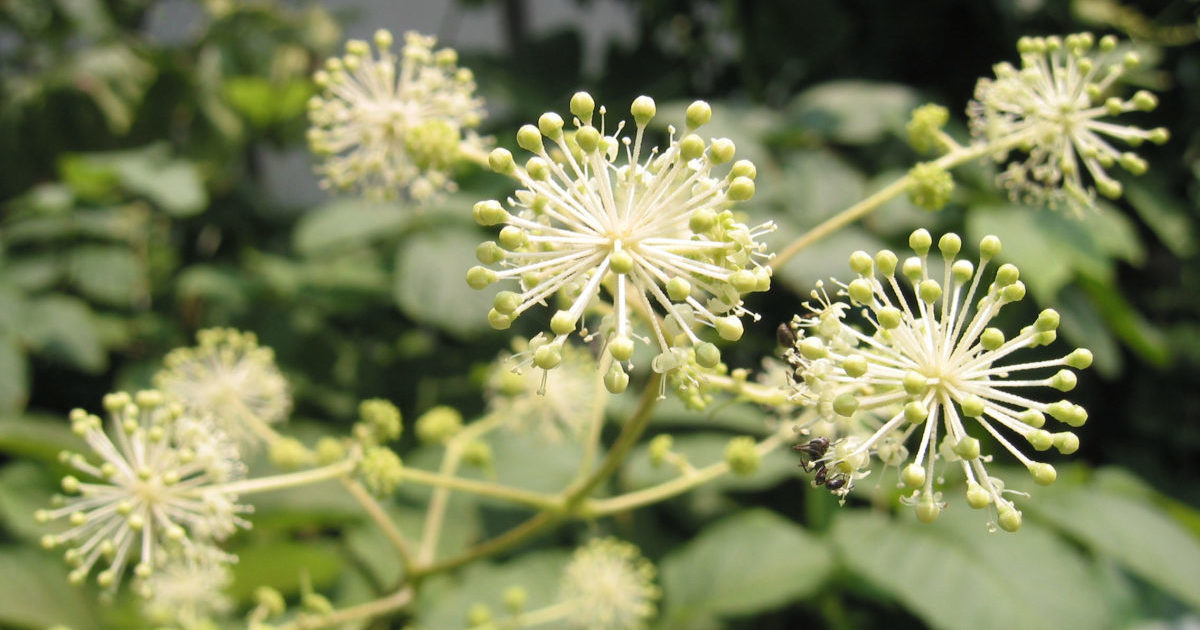 Aralia Manchurian - medicinal properties and contraindications, the use of tinctures in bodybuilding
Aralia Manchurian - medicinal properties and contraindications, the use of tinctures in bodybuilding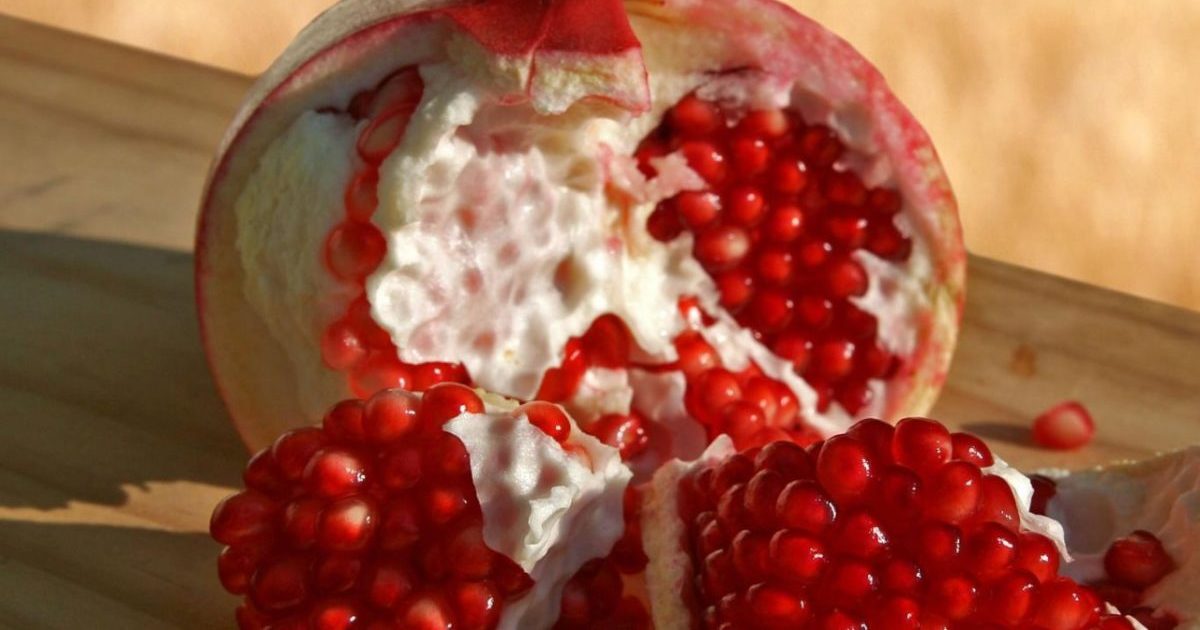 Seedless pomegranate - cutaway appearance, benefits and harms
Seedless pomegranate - cutaway appearance, benefits and harms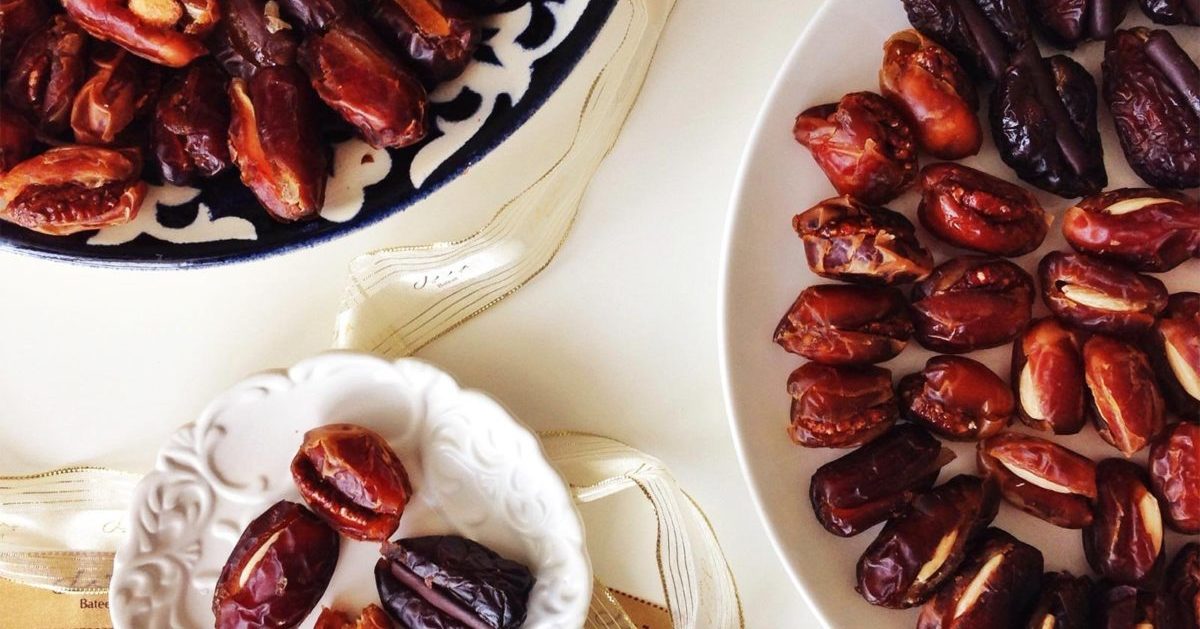 Dates - the benefits and harm to the body, how much you need to eat, properties and calorie content
Dates - the benefits and harm to the body, how much you need to eat, properties and calorie content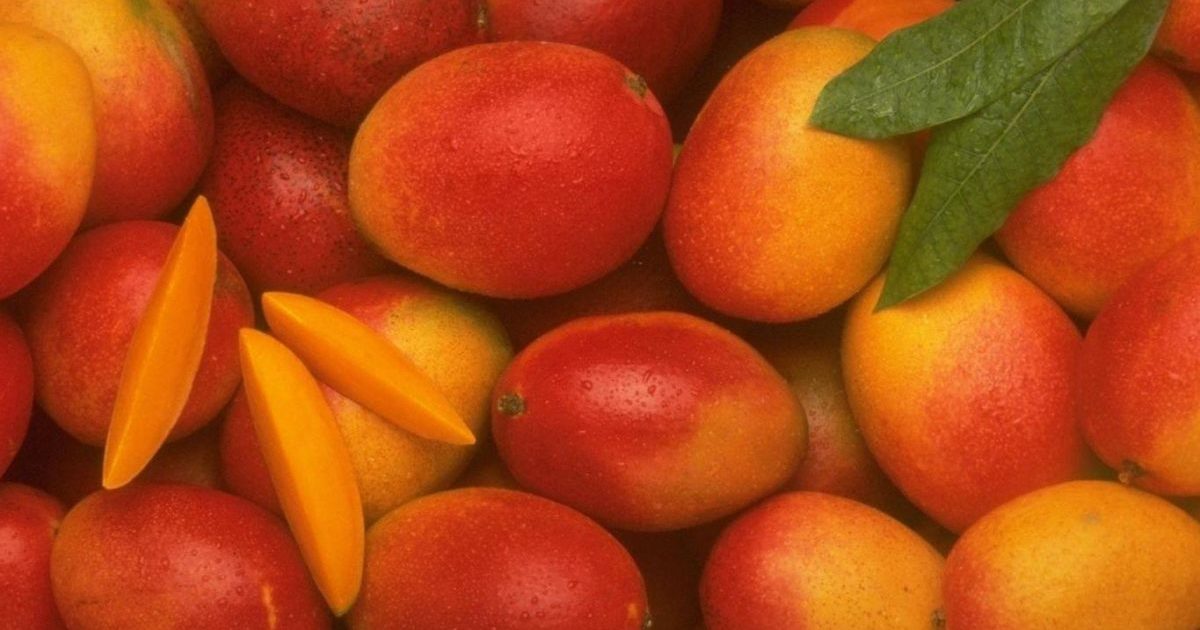 The benefits and harms of mango for the body of women and men - how to eat it?
The benefits and harms of mango for the body of women and men - how to eat it?